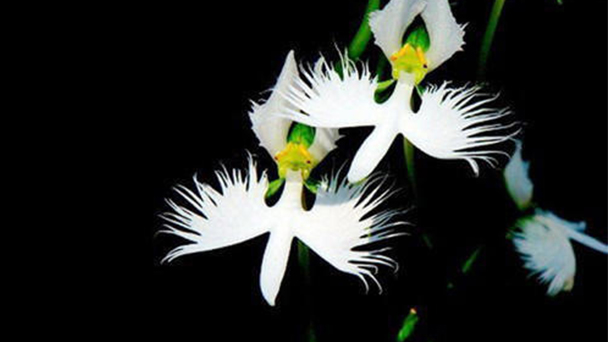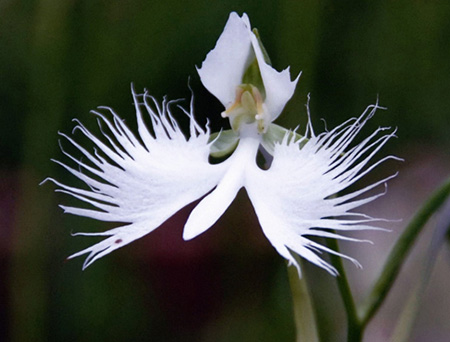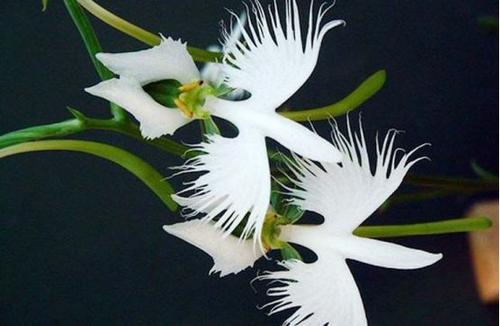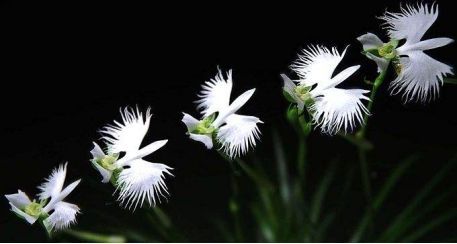Habenaria radiata profile
Written by Maggie
Mar 30 2021

Habenaria radiata looks like a bird in flight. Glittering white blooms of exotic flowers in May-June. Another species, Hydnora africana, usually grows in arid and barren desert areas. It is usually hidden in the bushes that act as a host. It is difficult for people to find its traces and can only find its traces through its unpleasant smell. Let's go to learn more about Habenaria radiata.
Habenaria radiata, native to Korea, Taiwan and Japan, belongs to the Orchidaceae family, and 12 species are known to be recorded. Because habenaria radiata is very beautiful, the number has been drastically reduced due to excessive harvesting. It is already an endangered plant and is in the top ten strange Ranked third among plants. Hydnora africana is a native plant in southern Africa. It usually grows in arid and barren desert areas. This kind of flower grows underground, except for flesh-like flowers exposed on the ground, releasing a corpse stench that attracts dung beets. , Corpse beetle. The true function of the beautiful bright red flower is a trap that attracts beetles into the flower, and then traps these beetles until they die. It absorbs the nutrients from the dead beetle. Flowering period July to September, white flowers, pedicels 20-50 cm high, with underground stems. Flower language is mysterious.
Habenaria radiata picture

Morphological characteristics of Habenaria radiata
Habenaria radiata is a native plant in southern Africa. It usually grows in arid and barren desert areas. This flower grows underground. Only flesh-like flowers are exposed on the ground. Habenaria radiata are usually hidden in the bushes that act as hosts. It is difficult for people. It can only be found through its unpleasant smell. Habenaria radiata, belonging to sixteen "notorious" beautiful plants worldwide, is a plant of the genus Euphorbia. It is a native plant of southern Africa. It usually grows in arid and barren desert areas. It is usually called steppe-type euphorbia in Namibia. It is a silver-gray succulent shrub that can reach up to two meters in diameter and has a root Hard as wood and shaped like a honeycomb. Jackals and baboons, like the Khoi-San people in South Africa, eat the fruits of Hydnora africana flowers "with confidence". Based on this characteristic, the locals call it "the bushman's salad". The ideal parasitic relationship in plants is "neutral parasitism." According to this parasitic relationship, parasitic plants will cause little or no damage to the host. Euphorbia plants are lucky: Hydnora africana, which emits a foul smell and is "neutral parasitic", does not cause any harm to it.
In addition, Habenaria radiata is native to Korea, Taiwan and Japan. The flowers of this plant look like a snowy egret with light wings, so it is also called Habenaria radiata, but it is completely different from Hydnora africana.
The growth habit and distribution of Habenaria radiata
Sunshine: full day or half day
Management: When the upper part of the local area withers, Habenaria radiata must be moved to a shaded place for storage
Moisture: sex likes moisture; from spring to autumn, the surface of the pot soil is dry and white, and it is necessary to fully water; the high temperature in summer will make the potted plants sultry and easy to get too wet, so pay special attention when watering.
In winter, the upper ground will wither, so you need to water Habenaria radiata every 2 to 3 weeks and keep the pot soil slightly moist.
Distribution: common in sunny and humid places.

The reproduction method of Habenaria radiata
Habenaria radiata is commonly used to propagate by seed, and it has better reproductive properties.
Habenaria radiata seeds are difficult to germinate without being treated aseptically. The seeds are treated with 75{bf} ethanol for 10 s 1{bf}NaClO for 10 min, or 40 kHz ultrasonic waves for 2.5 min 1{bf}NaClO for 10 min, at 1/2MS The germination rate of the medium can reach more than 58{bf}; in 1/2MS medium, the addition of GA31 mg·L-1 can promote the growth of leaves, and the addition of IAA 1 mg·L-1 has a positive effect on root growth and bulb formation. Promoting effect, the formation rate of bulbs reaches 55{bf}; the bulbs that are aseptically propagated are stored in pots in spring, and the seedling rate is about 72{bf}.
Habenaria radiata is a wild ground orchid distributed in the wetlands of Taiwan, the Korean Peninsula and Japan. The flower shape resembles the flying egret, and the potted plants are of high ornamental value. Habenaria radiata seeds are difficult to germinate under natural environmental conditions, and the bulb reproduction rate is low, generally only 2 to 3 times.
Habenaria radiata care
Habenaria radiata is native to Asia having delicate white flowers on the ear, usually 5 to 9 inches long and sometimes longer. Habenaria radiata grows from succulent tubers with ribboned dark green leaves.They appear more slowly in spring.
Light/watering: Habenaria radiata grows in partial shade under full sun. If there isn't enough rain, water to keep the plants evenly moist, but not wetted.
Fertilizer/soil and pH : Habenaria radiata grows best in well-drained, slightly acidic, humus-rich soils. When flowers sprout, lightly apply 1 to 2 times with 10 to 20% of the recommended amount of general plant feed.
Continuous care: Cover Habenaria radiata in winter, remove cover in spring to allow plants to grow. If Habenaria radiata is not hardy (zone 5 and colder), it can grow in a container and take it indoors to a cold place to sleep.In warm climates, plant Habenaria radiata in pots to allow your plants to return to the outdoors after three months of cold winter (30-35 degrees Fahrenheit or less).

Latest Updated
- Benefits of Bugleweed - 7 Science-backed Health Benefits
- Bugleweed Dangers & Side Effects - Is It Poisonous?
- How to Plant Evergreen Trees - What You Should Know
- When to Plant Evergreens - Grow Guide for Evergreen Trees
- 12 Wonderful Evergreen Shrubs for Your Garden
- 12 Popular Evergreen Plants with Pictures for Beginners
- When And How To Prune A Lilac Bush Like a Pro
- How to Grow & Care for Lilac Vine (Hardenbergia Violacea)
- Japanese Lilac Tree (Syringa Reticulata) Care & Propagation Guide
- Shumard Oak Pros and Cons - What to Know
Popular Articles
- Winter maintenance of Antirrhinum Majus
- How to Grow Terminalia Mantaly Tree
- How to Grow and Care for Crossostephium Chinense
- How to grow Antirrhinum Majus in spring
- Peristeria Elata (Dove Orchid) Profile: Info & Care Guide
- Underwatered Snake Plant (Sansevieria Trifasciata) - Signs And How To Fix
- How to Care for Brazilian Jasmine Plant (Mandevilla Sanderi)
- How to Grow & Care for Graptopetalum Purple Delight in Summer
- Rosa Chinensis (China Rose): Plant Growing & Care Tips
- How to Care for Baby Sun Rose (Aptenia Cordifolia)